“Exhibitions are places where meanings operate in a dynamic fashion. Artists go there to display their dreams. We all go there to restore our hopes. Where do we all go when they shut down?”
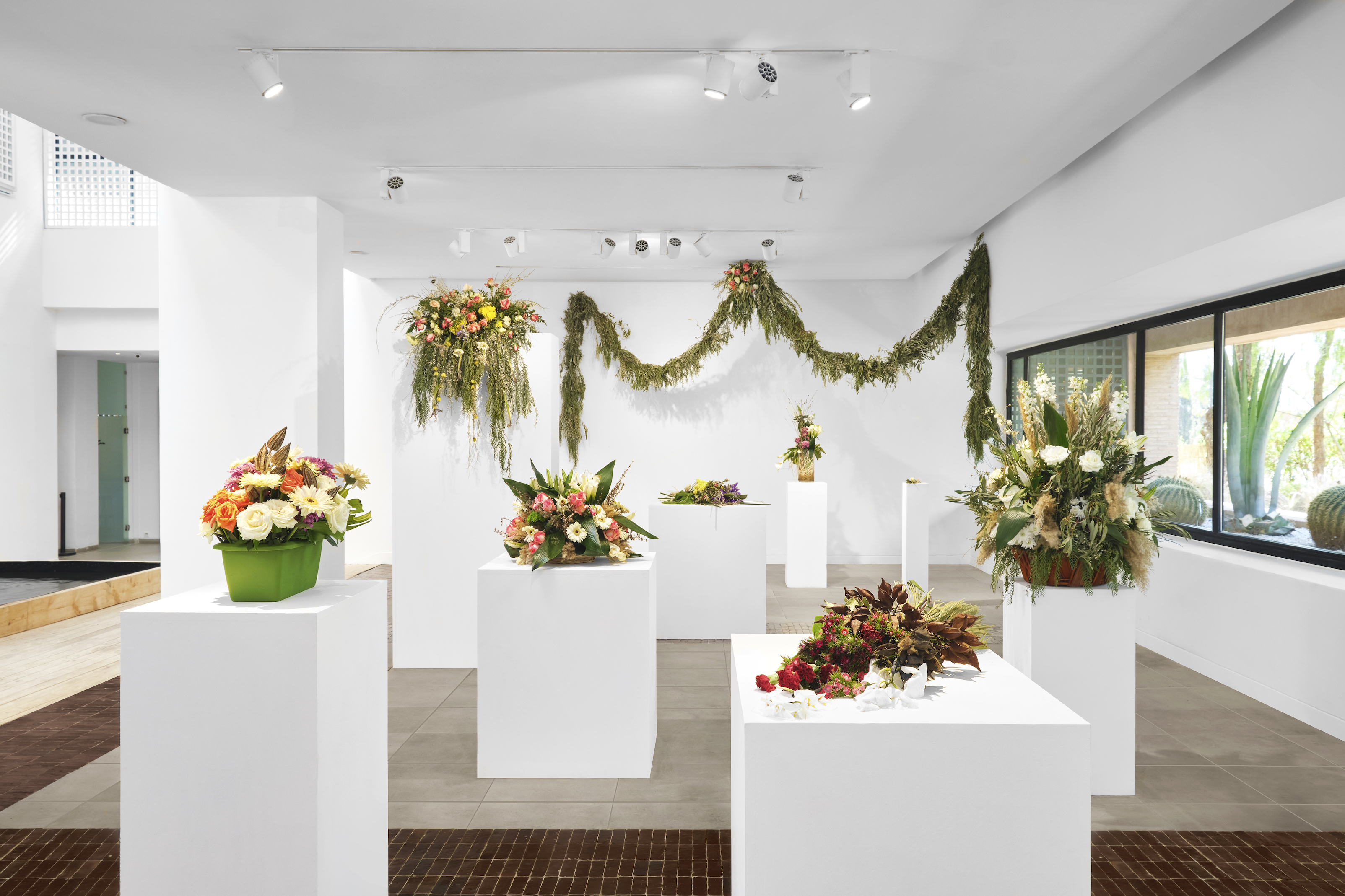
We suspected Yoko Ono’s song—the one that inspired the title of the show—to sound a bit pessimistic: ‘Have you seen a horizon lately / If you have, watch it for a while. / For you never know / It may not last so long.’ Our first encounter at the exhibition was a large panel, half-sign, half-instruction, hanging on the museum’s façade. Displayed in the purest tradition of early conceptual art—minimal black text on a white background—the title reads like one of these famous scores. We would cross the threshold of the museum, ignoring that it actually suggests an imminent end. In fact, we preferred ignoring it. In a quest for novelty, we instead decided to focus on the pledge of promising paths opened by the show. But it is rare for an exhibition to sound both as a loving warning and the promise of something to come. It is rare for a show to place its visitors in the middle of a tension between the possibility of loss and the care for the present moment. It is even rarer for the course of events to turn an exhibition into a direct commentary on our common future. Rare but somehow pleasing.
‘HAVE YOU SEEN THE HORIZON LATELY?’ opened in February 2020 as part of the 1—54 Contemporary African Art Fair, at the Museum of African Contemporary Art Al Maaden (MACAAL), Marrakech, curated by Marie-Ann Yemsi. The collective exhibition addresses the unbearable evanescence of our horizons with a surprising resonance beyond its temporality. We saw the show for a moment, then lost sight of it. The show also addresses ways of emancipating our visions and taking action in a world in loss of meaning. It assures us that faced with predictions of the society’s imminent collapse we can still rely on artists’ ‘subtle perceptiveness’ in dealing with the fragility of our horizons.
We would start, for instance, by making the case for a new vision of society. Maxwell Alexandre takes the lead by challenging our imagination of discriminated groups portrayed in typical scenes of everyday life in Rocinha, one of the largest favelas of Rio de Janeiro in Brazil. Anonymous black-painted bodies celebrated in their habitual gestures and features convey his intent to politically subvert meaning. It is, on the one hand, a subversion of vision, through a hybrid use of techniques sprinkled with references to Art History, rap or religious iconography. On the other hand, Alexandre crafts a subversion of our frame of perception. Scattered on a table and suspended in a space caulked with brown paper, the patterns in his work Pardo é Papel: First Contact (2020) are both fragile and highly engaged. His use of Pardo—an ordinary brown wrapping paper—reveals an even more ambitious project shaping an alternative history of the favela. The work states the unbroken knit of a resilience invented day by day. As if in Rocinha each new day under the sun is lived as the same everlasting day. We all know our so-called ‘slums’ simply reflect social inequalities. Yet, Alexandre’s piece suggests that the spatiotemporal exclusions they imply supersede our common societal horizons.
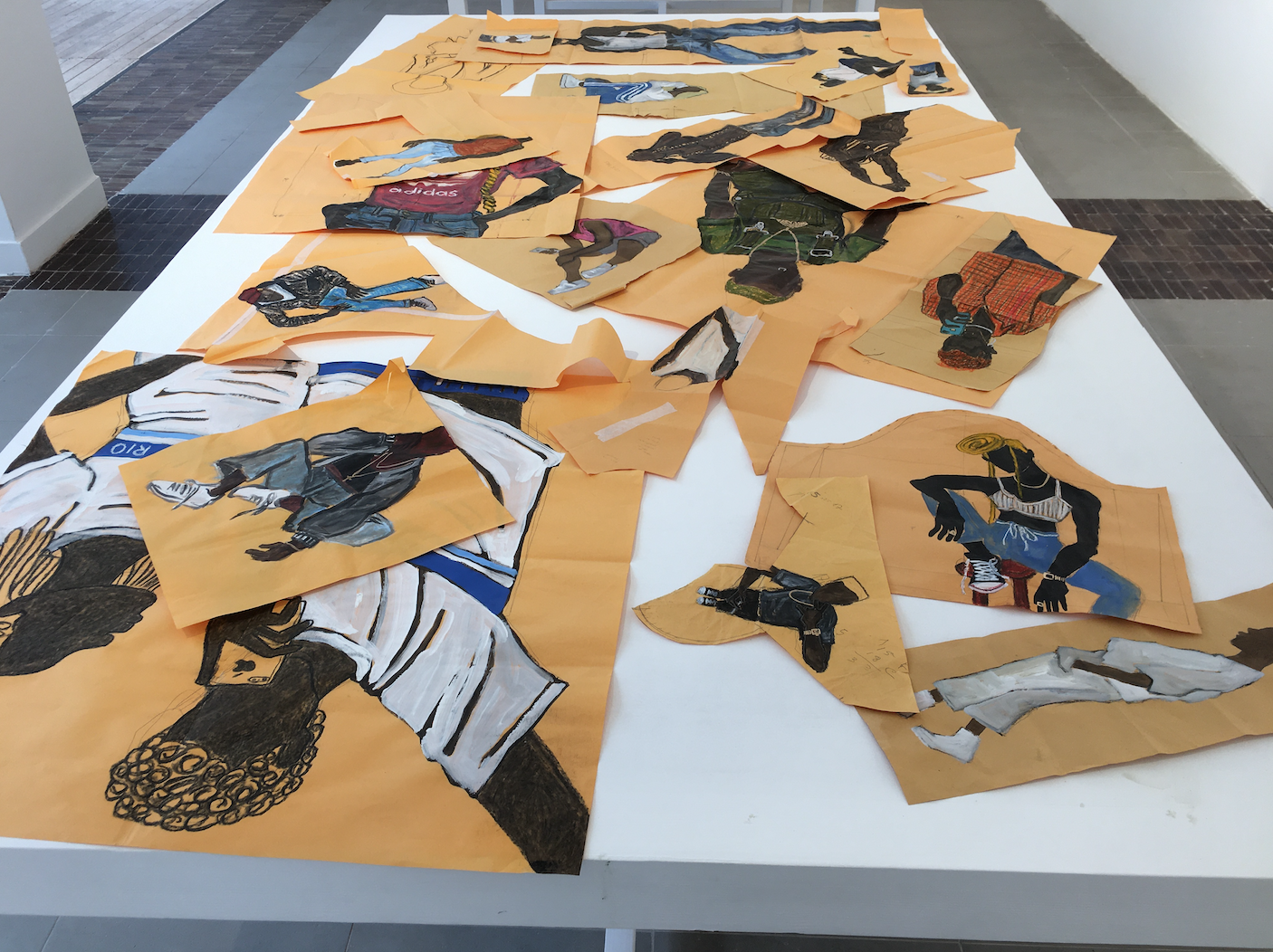
When did dreams also become unequally distributed spaces? Overturning our dreams of society can hardly happen without tackling the very roots of our ideals. Kapwani Kiwanga gives a striking demonstration of how to question the frameworks of our expectations. She redesigned bouquets of flowers that served as decoration during African independence ceremonies. A display of withering posies on pedestals, Flowers for Africa (2013 – in progress) highlights the fate of such historical documents. Flowers! They sprout under different seasonal conditions from Harare to Algiers. Yet, as archival material, they recount a common element of fate: the forgotten memories of nations’ struggles for independence; the disenchantment which succeeded the enthusiastic promises of freshly acquired sovereignty; and, ultimately for the visitor, the unbearable vertigo of vanity. This is brilliant!
The exhibition is strewn with references to the role of socio-political frameworks in shaping our realities. With an integrated scenography by Franck Houndegla, the show metaphorically substantiates that time and space are all relative concepts. Each room re-conditions the visitors for a new story. And, as we move from one room to another, we learn there are no long-term horizons, except those that prevail in the present. The challenge, when possible, is to not let them out of our sight. And if time and space are political constructs, the disruption of a society logically disrupts its horizon. The horizon at stake in ‘HAVE YOU SEEN THE HORIZON LATELY?’ is a precarious one. Such is, for example, the storyline of Concrete Affection – Zoppo Lady, (2014), a video installation by Kiluanji Kia Henda. Against a backdrop of political upheavals in Angola in 1975, the Portuguese were compelled to leave the country in numbers during the Angolan independence, witnessing the collapse of their colonial dreams. The crates used to transport their goods back then became symbols of the material dispossession of the colonists. Kia Henda’s murky film describes the dizzying stroll of an Angolan-Portuguese crisscrossing the deserted streets of a ghost town. Stacked from floor to ceiling around a dark concrete antechamber, the boxes of this installation tell the story of decadence, as the subjective camera reinforces the torment of a dystopian end of the occupation. Such a reversal of the narrative—call it the colonist’s distress—describes the entanglement of our destinies. Kia Henda thus demonstrates the inextricability of a decolonial reading of our world. The rising of some and the diminishing of others seem to intersect on the same steep and fragmented line of destiny.
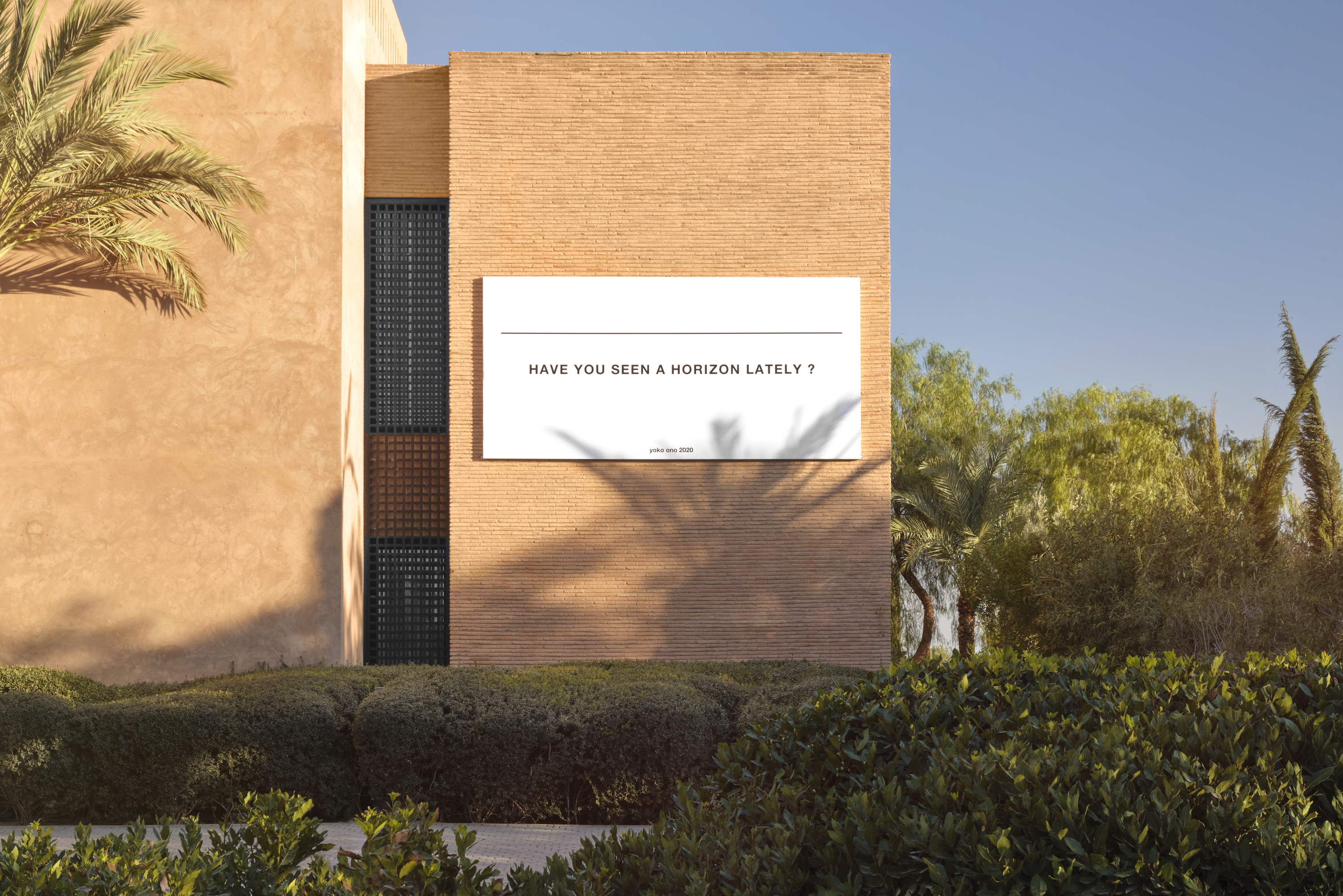
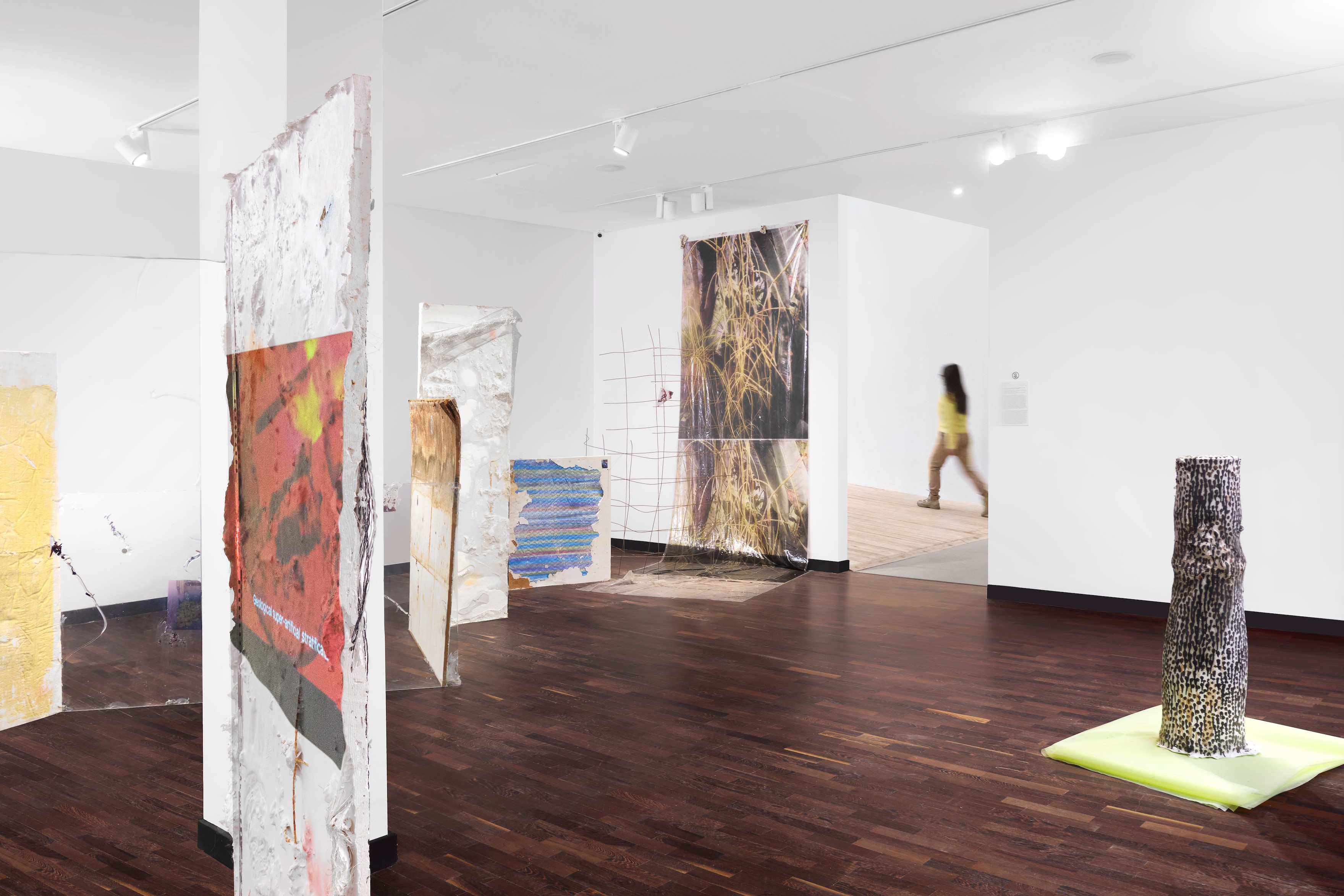
Kiluanji Kia Henda’s piece left us a bit groggy, almost uncertain of our original quest. The fact is, interventions like his illustrate the intention of the curator. Marie-Ann Yemsi invited the artists to “infiltrate the invisible folds of the world” to redraw its contours. When you do this as a curator, you are putting together a show that is daunting and thought-provoking. The entire show is marked with milestones for (un)learning. That’s how urgent the situation is. Reinventing the future—an absolutely fleeting notion—amounts to getting rid of our paradigms as if they were skins. If the show’s sense of urgency had a climax, it would certainly be Gaëlle Choisne’s video installation N. E. V. A. Q. N. A. L. A. (2016-2020) an acronym for “… nous étions les victimes alors que nous avions été les auteurs” (“…we were the authors, and later the victims”). Drawing from a quote from Tristes Tropiques (1955), by the French anthropologist Claude Levi-Strauss, Choisne built her piece like a pathway. She composed a poem at the expense of its aesthetic pleasure. Her proposal is an extraction of references (mythology, colonial history, science-fiction, voodoo, Haiti), of materials (plaster, glass, metal, ceramics), and of events (straw rectangles placed on the ground like screens, neck chains, cigarette butts, sculptures), all brought together in praise of composite imaginaries! Whilst an ambient computer voice delivers a sort of post-apocalyptic message, Choisne seems to exhort us to merge rhythms, to find new balances, and to accept the poetry of incompatibilities. That’s one of the ways to build forms of resistance. We left the room with a stale aftertaste—like ones you get after swallowing a medicine. They are only as unpleasant as they take part in your healing. Plus, we can hardly imagine the effects of the frenzy of uncontrolled progress.
The deepness of the injuries caused by human action is barely conceivable unless it is seen. In his work, Akira Ikezoe gives us a glimpse of how absurd the system of our deeds can be. Ikezoe’s surrealistic and minimalistic paintings are ‘diagrammatic cosmogonies’ in which “the human body is an element of nature and the environment is the extension of the human body”. Tiny figures are represented like oblivious fools with a coconut in lieu of a head. Why would Ikezoe flatten the hierarchies of the real if not to show the ongoing tragedy with our commons: consumerism, exploitation of natural resources, profiting, and so forth. We have the choice between the absurd loop of Ikezoe’s Coconut Heads (2013 – Ongoing) and a tangent. But what tangent? What is there outside of our productivist reflexes? Who grew up out of this economy of waste?
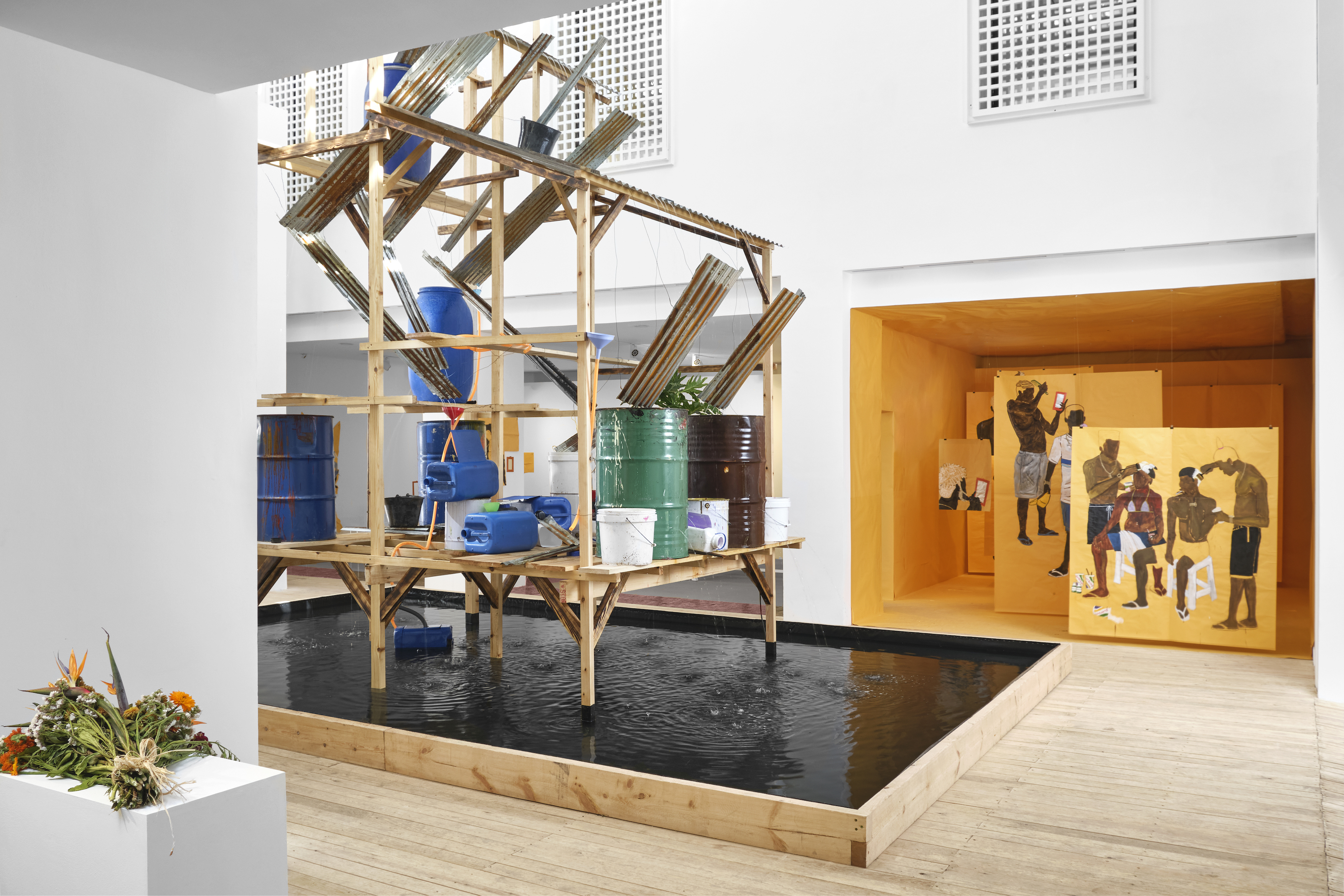
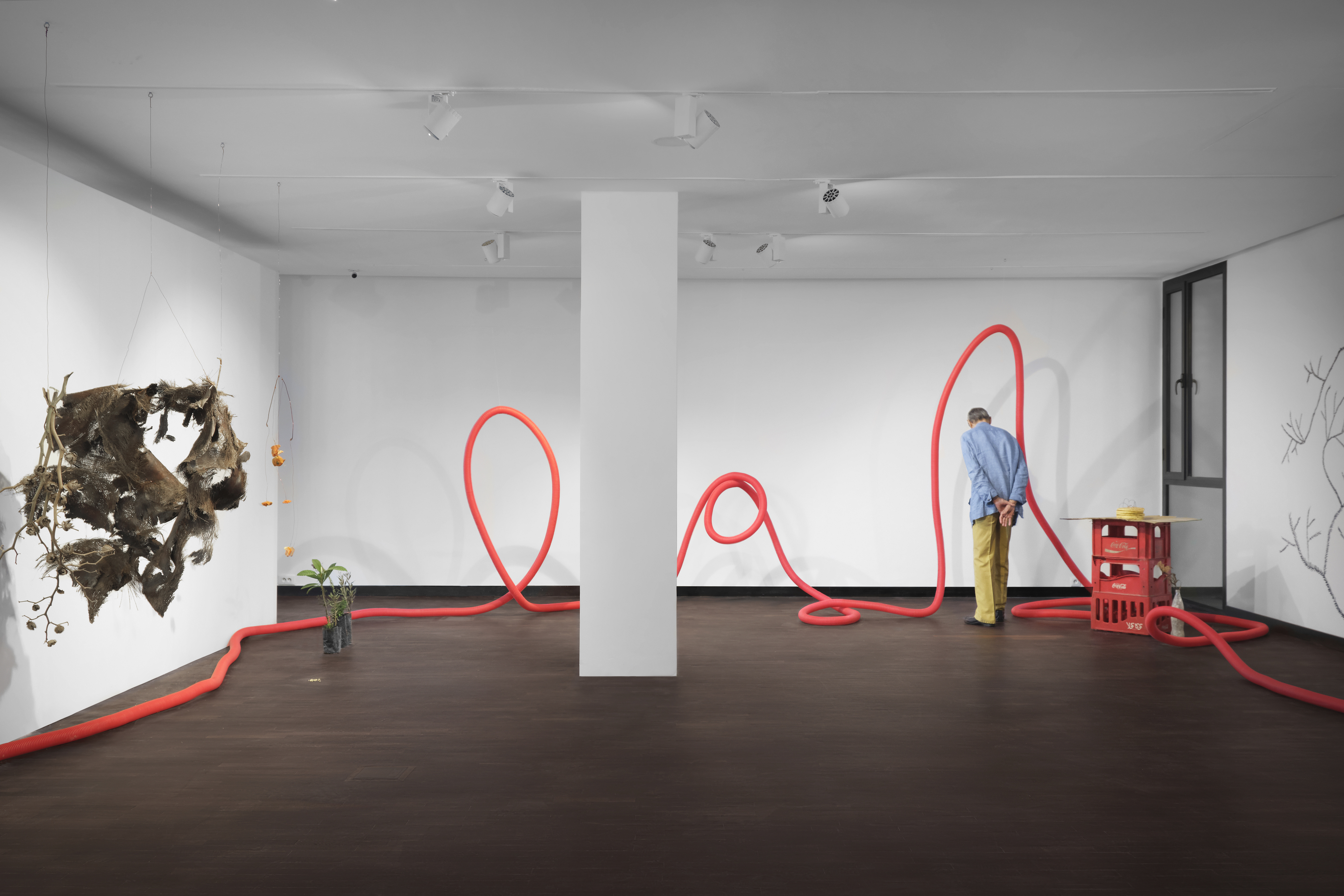
The urgency to reinvent ourselves is inseparable from a philosophical meditation on ecology. One of the ways we can protect ourselves from ecological fatigue lies in the untapped resources of care. In this exhibition, care is a mindful integration of limits and scales. Care is, for instance, at the very heart of the rainwater recycling technique of the Emberá communities, on the banks of the Atrato River (North-West of Colombia). Their intelligent sense of preservation inspired the piece Lluvia (2019) by Daniel Otero Torres. Lluvia is a scaffolding raised in the museum’s main nave. It is a wood-and-sheet metal framework of streams of water runoff to an array of perforated drums. A living fountain on its own, this machine’s material paucity reinforces its ingenuity. Water renews itself by the magic of hydrodynamics, while the familiar sound of the runoff surrounds the museum right through. This fountain is not only poetic; it is also ironic because it is installed in the heart of a museum, a few hundred meters from a golf course, on a planet where flowing water threatens to be the next scarce resource. Artistic proposals rarely address this issue with the same relevance. Another example is A Walk Sculpture (Marrakech) (2020), by Rahima Gambo. Gambo dedicated her residency period at the MACAAL, prior to the exhibition, to the mindful ingathering of spatial features. Her work is a poetic and multisensory mapping of the territories she crosses in her meanderings through the city. It also honours the space with a visual taxonomy of the things gleaned from the city of Marrakech: dried fruits, branches, obsolete objects, sounds and images, plants, stones, cardboard, etc. In a playful and almost infantile way, the work says: “Look, here is what I found. There’s this too. This one’s for you. Take”. Gambo sees walking as an offering to oneself. It is simple and reproducible by anyone anywhere: one walks as they meditate whilst the artwork is in the making. By linking the body’s ecology with the artwork’s ecology, Gambo invites the viewer to rethink their relationship with being. She extends the horizon line from a geographical standpoint to an existential one, thus putting the visitor in dialogue with what is. Full stop. Bare beings and the thingness of things, nothing more. She applied a kind of Hegelian Dasein to Marrakech.
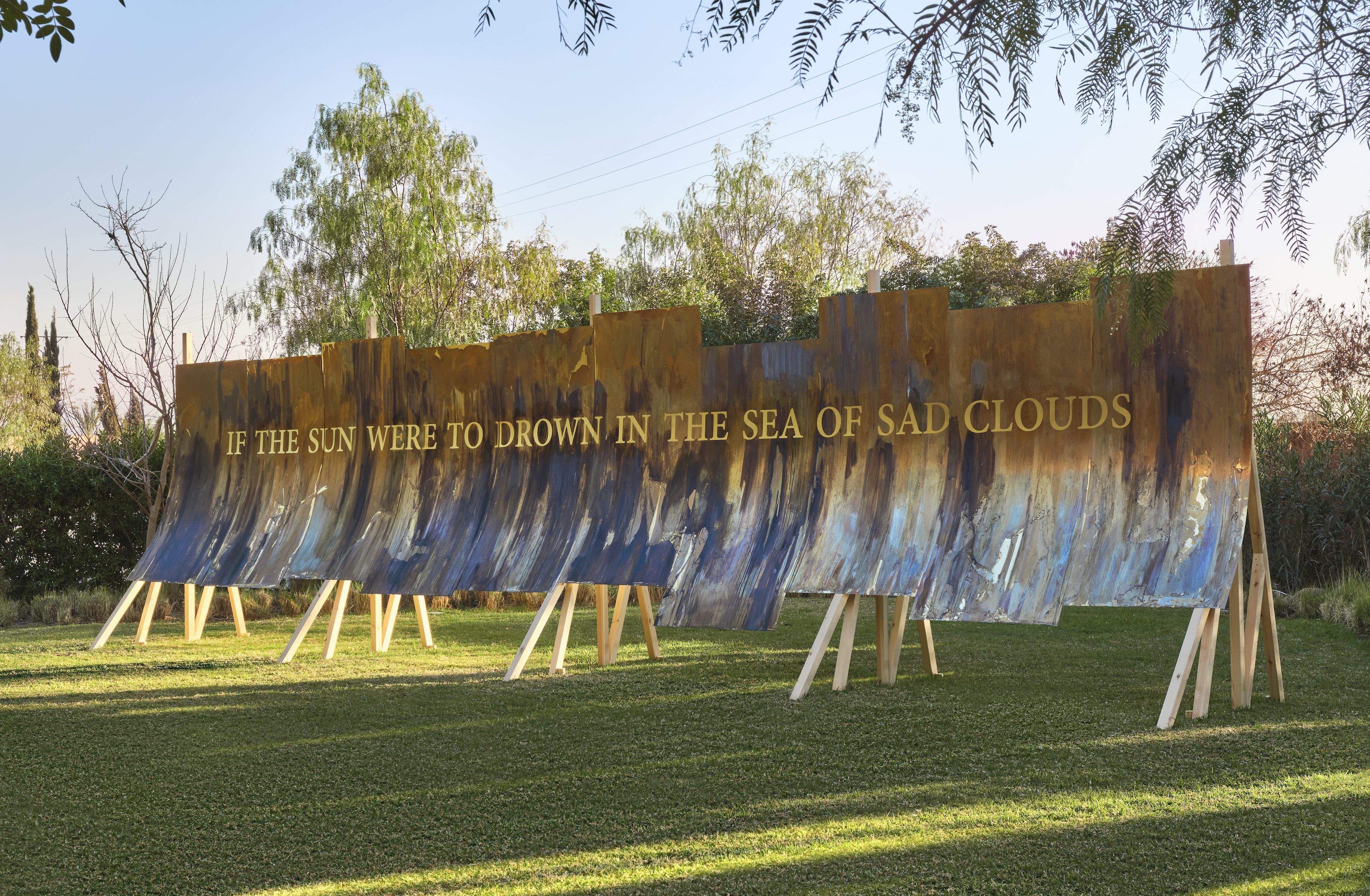
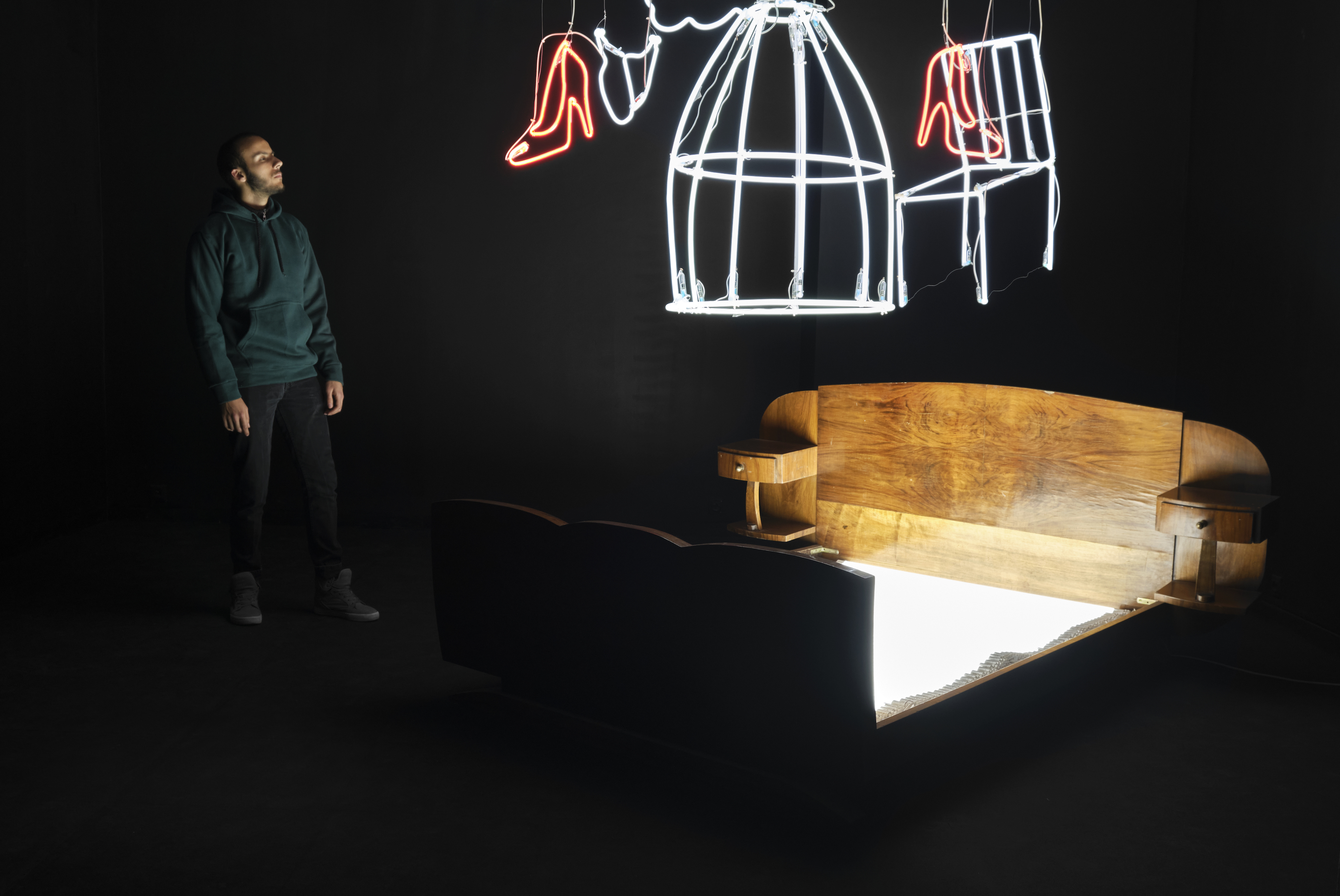
Exhibitions are places where meanings operate in a dynamic fashion. Artists go there to display their dreams. We all go there to restore our hopes. Where do we all go when they shut down? They all said ‘Until further notice’, or ‘Until further instruction’. Yes, but when? “Have you seen an evening light lately?” Yoko Ono sang on that karaoke-sounding track. “If you have, watch it for a while. For you never know, It may not be the same”. Are we there yet? Did we witness the changing of the ‘evening lights’? In 1973, when she released the song in the album Approximately Infinite Universe, Ono was already known as one of the seminal figures of conceptual art, a pioneer member of Fluxus and a strong voice of postwar feminist art. She held events at her loft at 112 Chambers Street in New York City and was known as a one-woman powerhouse. Someone even named her the “High Priestess of the Happening”. The point is: by defying established paradigms, the works on view in ‘HAVE YOU SEEN THE HORIZON LATELY?’ echo a 60 years old tradition of criticism initiated by Ono and her peers. Such resonance—and the story of this show at large—might have been different without the role of her ‘instructions’. Instructions are these short statements meant to be executed, but also stand as language-based works of conceptual art. The instructions can be performed indefinitely. Ono used them as a method to navigate between conceptual planes, between spheres of her practices, and even between ages. So, from a song in 1973, ‘HAVE YOU SEEN THE HORIZON LATELY?’ became the first Yoko Ono retrospective at the Museum of Modern Art Oxford in 1997, an exhibition at MACAAL, and a 2020 iteration of the original piece displayed as a series of posters within the exhibition itself. By orchestrating the responses from a dozen of international artists, Marie-Ann Yemsi has restored the qualities of transcendence embedded in Ono’s instructions. This said, the instructions happen to have a mantra that says: ‘Anyone can execute them, if only the mind can allow the imagination to run free’.
This cannot be more true in our current times. Against the feeling that our horizon is being blurred by the outbreak of a pandemic, here is our call to all: Find some instructions. Execute them, or simply meditate on them. Start with, say, Ono’s 1964 Grapefruit, they are more daring. If in doubt, find a window at home or on the internet: Ask for instructions. We now know they transcend time and space. Your ultimate goal would be, as Moroccan poet Abdellatif Laabi puts it:
to embroider the name of a star
that will rise after the next apocalypse
to see the unbreakable thread among thousands
to weave from the fabric of passions
swaddling bands, overcoats, winding cloths
to carve a beginning from a pile of waste
Two hands aren’t enough to write
These days
with its grinding miseries
it would take three or four
for life to bother visiting
this wretched white wasteland.
–
HAVE YOU SEEN A HORIZON LATELY? is on view from February 25 till July 19, 2020.
–
Untitled (Soukaina Aboulaoula & Yvon Langué) is a young curatorial and artistic direction duo based in Marrakech. Untitled is interested in the possibilities offered by text and form in shaping cultural practices at large.




